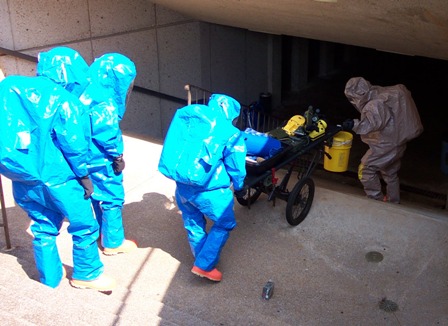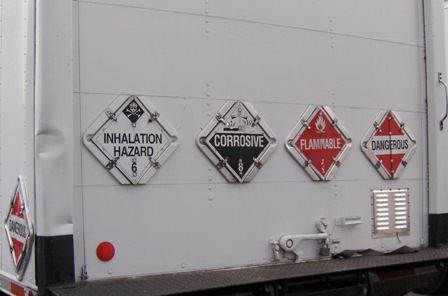Services
Scope of Services
In an era of increasing regulation in all facets of safety, health, fire protection, emergency response, and environment MTSU Environmental Health & Safety Services (EH&S) provides vital services to all University Departments. In addition to providing consultation, investigation, and inspection services EH&S also provides assistance in the areas of employee training, guidance on regulatory record keeping and reporting for OSHA, EPA, the Tennessee State Fire Marshal, and other regulatory agencies.
Summary
Department resources are often over taxed in attempting to maintain safety programs and regulatory compliance. Development of new programs that require staffing and funding to meet changing regulatory requirements often remains undone. EH&S provides vital services to the University by assisting departments in achieving regulatory compliance in the areas of safety, health, environment, fire protection, and hazardous materials. The EH&S staff is well versed in all aspects of safety program administration, emergency response planning, and regulatory compliance and is very capable of successfully organizing and developing safety services to meet present and future needs of the University.
Services
EH&S personnel have a strong background in the areas of expertise necessary for development of comprehensive institutional, division, college, and departmental safety programs:
Leadership and Administration
EH&S is knowledgeable of the requirements of a comprehensive safety program and has the ability to coordinate and implement safety program functions. EH&S also has an extensive library consisting of the latest safety and environmental standards, building and fire codes as well as work practice reference information compiled from a variety of sources.
Planned General Inspections
Inspections can be conducted and reports completed and analyzed in critical or hazardous areas. Every facility should be inspected at least annually by an independent third party and critical or hazardous areas more frequently by the administrators, directors, or managers responsible for those areas.
Accident Investigation
Accident investigation procedures can be improved by training of first line supervision. Injuries and illnesses should be investigated first by first line supervision and then reviewed by management. Unusual or serious injuries and illnesses may also be investigated by EH&S when requested. All fires or explosions should be investigated by EH&S for the purpose of determination of cause and origin. Vehicle accidents can be reviewed by EH&S and further investigated if they are serious or involve unusual circumstances.
Safety and Health Complaint Investigation and Evaluation
 All complaints of hazards related to safety or health are investigated and evaluated
by EH&S. Every employee has the right, in accordance with state and federal laws,
to make anonymous safety, health, and environmental complaints. EH&S shall be provided
copies of any documents on request, from any department, that it deems pertinent to
the evaluation of a safety or health complaint. EH&S will determine the actual degree
of hazard of the complaint item, determine any associated regulatory issues, recommend
any program changes or corrective actions necessary to control the hazard, and issue
a report of findings to the department head, appropriate administrators, and the EH&S
Committee. These reports may also be reviewed by representatives of the Tennessee
Board of Regents and the Tennessee Occupational Safety and Health Administration.
All complaints of hazards related to safety or health are investigated and evaluated
by EH&S. Every employee has the right, in accordance with state and federal laws,
to make anonymous safety, health, and environmental complaints. EH&S shall be provided
copies of any documents on request, from any department, that it deems pertinent to
the evaluation of a safety or health complaint. EH&S will determine the actual degree
of hazard of the complaint item, determine any associated regulatory issues, recommend
any program changes or corrective actions necessary to control the hazard, and issue
a report of findings to the department head, appropriate administrators, and the EH&S
Committee. These reports may also be reviewed by representatives of the Tennessee
Board of Regents and the Tennessee Occupational Safety and Health Administration.
Emergency Preparedness
MTSU has well established relationships with both the Murfreesboro Fire Department and Rutherford County Emergency Medical Service for assistance and mutual aid during most emergencies encountered on campus. EH&S has a statutory responsibility for emergency planning and response and developed the institutional Emergency Operations Plan. EH&S can assist departments in developing customized emergency plans within the framework of the institutional plan that address unique departmental needs. Community Emergency Response Teams can also be developed and trained. The emergency plan can also provide a list of external resources.
Accident/Injury/Illness Analysis
 EH&S compiles data and statistics concerning the types and severity of losses due
to accidents, injuries, and illnesses. The institutional lost work day incidence rating
is calculated each year and compared with state and national ratings in order to assess
overall safety performance.
EH&S compiles data and statistics concerning the types and severity of losses due
to accidents, injuries, and illnesses. The institutional lost work day incidence rating
is calculated each year and compared with state and national ratings in order to assess
overall safety performance.
Hazardous Materials/Hazardous Waste
MTSU is required by OSHA and EPA standards to have a qualified person on site when there is any activity, including storage, involving hazardous materials or wastes. EH&S has personnel trained to the Hazardous Materials Incident Commander level. All departments using hazardous materials must maintain their own files of material safety data sheets. EH&S also coordinates and oversees hazardous waste removals and prepares and submits required EPA documentation. Training is conducted by EH&S for all employees, including faculty, with a potential exposure to hazardous chemicals or handling hazardous wastes to meet the requirements established by OSHA and EPA. Systematic monitoring to evaluate potential or reported chemical exposures can also be conducted by EH&S.
Job/Task Analysis
EH&S can prepare critical task inventories for each job classification, particularly those in which an injury or illness has occurred. A systematic job and task analysis can be completed and implemented in order to identify reasonably anticipated hazards and develop engineering controls or work practice modifications to reduce the risks associated with identified hazards.
Organizational Rules
EH&S can assist departments in development of a customized site or department specific safety plan to provide general safety and health rules as well as those specific to any trades, crafts, or disciplines. An education and review program can also be developed to keep all employees informed of the latest requirements.
Employee Training
A training needs inventory can be conducted by EH&S to determine the employees requiring training mandated by OSHA and EPA. A general departmental employee training program can be developed for new employee safety orientation, accident reporting, accident investigation for supervisors, safety rules, safe work practices, and safety refresher training.
Personal Protective Equipment
A comprehensive personal protective equipment needs inventory and hazard assessment should be conducted where personal protective equipment is or should be provided. EH&S can assist departments in training employees in fit testing, proper use, and maintenance of personal protective equipment. Assistance in development of departmental personal protective equipment issue, fit, and maintenance records is also available.
Health and Infectious Disease Control
EH&S can develop and present customized employee training in avoiding contact with Hepatitis-B and HIV as well as development and implementation of a customized a Bloodborne Pathogen Exposure Control Plan where appropriate. EH&S can also determine employee noise, hazardous chemical, and air contaminant exposure levels in order to identify and control health hazards occurring from these exposures. EH&S can also provide training support for supervisors and employees in first aid and CPR as well as develop specifications for a unitized first aid kit appropriate to the department's operation.
Purchasing/Engineering Controls
EH&S can assist each department for development of safety and health requirements as part of purchasing policies and specifications.
Safety Meetings
All MTSU departments should conduct regular safety meetings at intervals appropriate to that department's operations with the guidance and support of management. EH&S can assist departments in development of a curriculum of planned and programmed safety meeting topics that can be presented periodically by management or first line supervision.
Compliance Evaluations
EH&S periodically evaluates departments to determine the level of compliance with regulatory requirements and industry standards. Records kept by the department can be audited by EH&S to evaluate compliance with standards established by the Occupational Safety and Health Administration, the Environmental Protection Agency, the State Fire Marshal's Office, and other regulatory agencies. A department's failure to meet regulatory record keeping requirements can result in penalties of up to $50,000 per day per violation.


